Contenido - Contents
2010-03-12 Gauranga visits the asrama, and parikrama of GirirajaCargado el 12 de marzo, 2010 por kepfenyek P1050773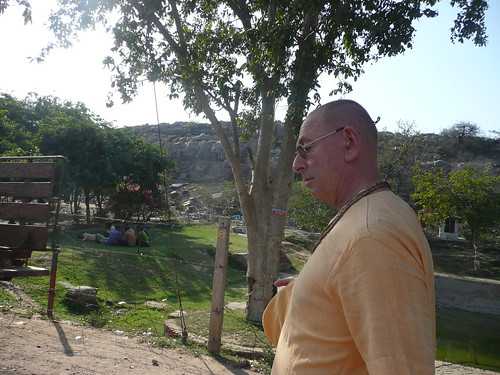 P1050774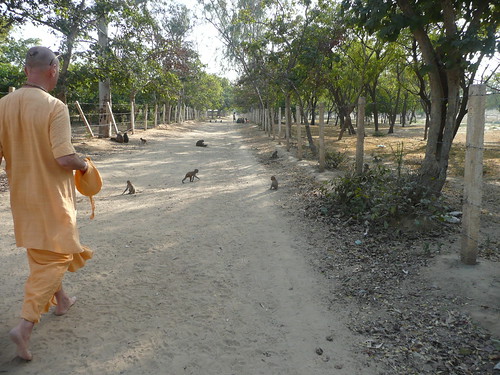 P1050778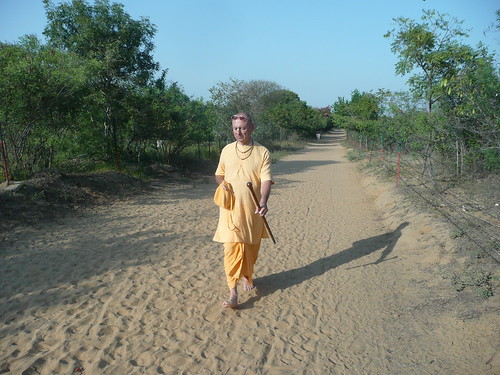 P1050779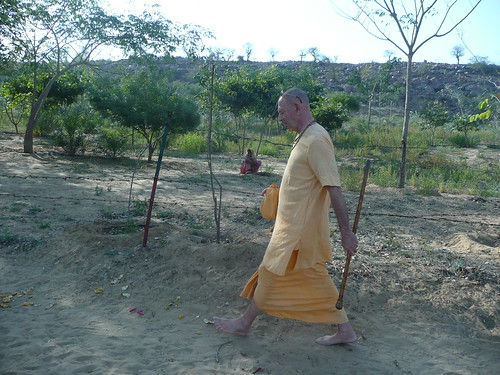 P1050781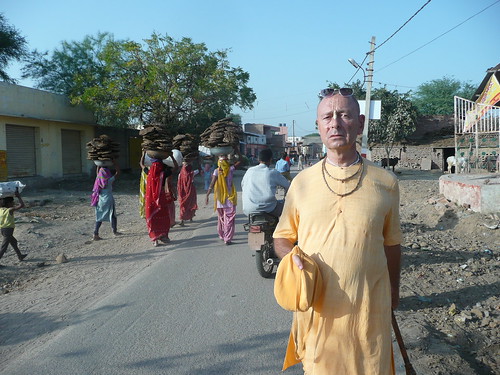 P1050782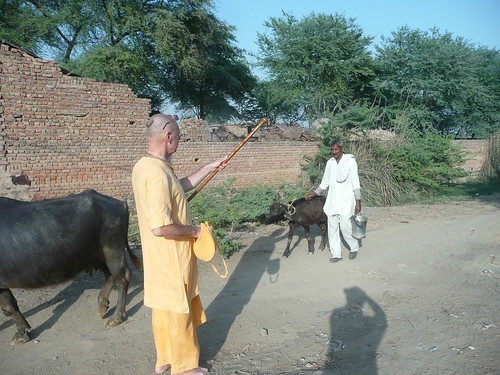 P1050785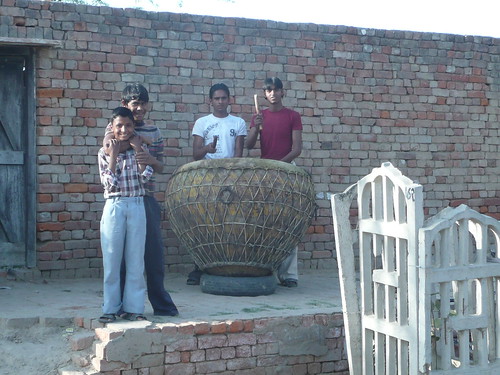 P1050786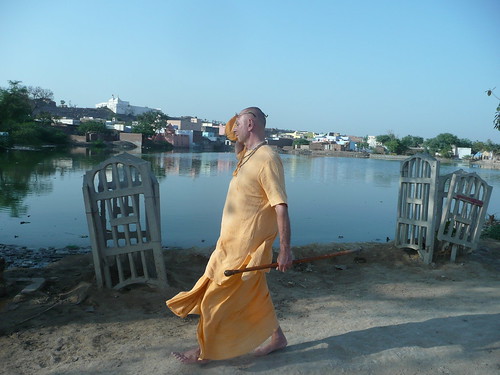 P1050787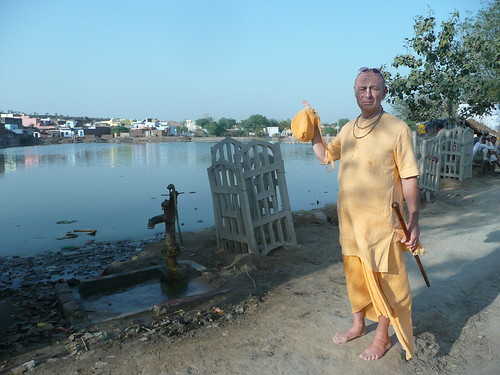 Uddîpana-vibhâvaUddîpana-vibhâva: (sáns. vaiëòava). Aspecto del vibhâva que se refiere a las cosas que estimulan el recuerdo de Ärî Kèëòa, como Sus vestidos y ornamentos, la estación de la primavera, las orillas del Yamunâ, los bosques, las vacas o los pavos reales. Vibhâva es uno de los cinco ingredientes esenciales del rasa (ver vibhâva). Uddîpana-vibhâva: (sáns. vaiëòava). An aspect of vibhâva which refers to those things which stimulate rememberance of Ärî Kèëòa, such as His dress and ornaments, the spring season, the bank of the Yamunâ, forest groves, cows, peacocks, and so on. Vibhâva is one of the five essential ingredients of rasa (see vibhâva). RASA IN SANSKRIT DRAMA - PRINCY SUNILContenido - ContentsSanskrit rhetoricians distinguish Kavya into two kinds: Drsya (that which can be seen) and Sravya (that which can be heard). In drama, Drsya takes a predominance over Sravya. It is because of its capacity to afford a two-fold pleasure that drama is considered as the best form of literature. Kalidasa, the veteran of Sanskrit drama, says: "Sages declare it to be a charming sacrificial feast for the eyes of the Gods. Siva bisected it in his own person which is made one with Uma. Here are seen actions of the world arising from the three qualities (Satva, Rajas and Tamas) and distinguished by various sentiments. Drama, though single, is a mainfold entertainment for people of diverse tastes". (Kalidasa, Malavikagnimitram, I.4). According to Bharata, Brahma created a fifth Veda called Natya for the benefit of all classes of people. For the composition of his work, he took Patrya from the Rig-Veda, Pathya Gita from the Sama-Veda, Abhinayas from the Yajur-Veda and Rasas from the Atharva -Veda. `Rasa’ is one of those words in Sanskrit whose precise significance is as indefinite as its usage is widespread. In the history of Sanskrit Poetics, perhaps no other concept has given rise to so much controversy. According to the renowned poet-critic Anandavardhana, poetic creation is an expression of the aesthetic experience of the poet, and in this, Rasa represents the ultimate emotive experience evoked by the literary work. Bharata served to compile the meaning of the multifaceted word `Rasa' in a single sentence. “RASYATE ANENA ITI RASAH (ASVADYATVA)" (Bharata, Natya Sastra, 28). (That which is relished is Rasa) Thus, we use this word in association with the palate, or the transcendental experience of the saint, the delight afforded by art and so on, and in all this, the word indicates the pleasure that each class of people receive from their respective experience. Rasa could be said to be a two-fold experience felt by the creator and his expression through his art and the experience of the reader (Sahrdayas) who receive the art. The creator undergoes an emotion and is so overwhelmed by it that he seeks a medium for the expression of his feelings. The reader receives this emotion through the creator's medium and thus undergoes the emotion felt by the creator. Thus the word `Rasa' is once again created by the creator and then is re-created by the reader. The extent to which the reader undergoes the emotion felt by the creator depends upon the intelligence of the creator in presenting it. The nature of our existence, which is a curious mixture of happiness and unhappiness is sought to be exactly represented in art media. For Lollota, Indian aesthetics is interminably based on the word `Rasa'. According to Bharata, "NAHI RASADATE KASCIDAPYARTHAH PRAVARTATE". (NS VI. 31). (No meaning can proceed from speech in the absence of Rasa) This proves the importance of Rasa in the aesthetics and literary criticism of India. Bharata, the first exponent of Rasa theory, is the well- known author of Natya The Indian Review of World Literature in English, Vol. 1, No. I – Jan, 2005 Sastra, the first Sanskrit book on drama, dance and music. According to him, Rasa is the essence of art. The Rasa - sutra occurs in the sixth chapter of the Natya Sastra: "VIBHANUBHAVA VYABICARI SAYOGADA RASANISPATTIH" (N.S. VI. 33). This means the realisation of Rasa results from the union of Vibhava, Anubhava and Vyabicaribhava, and its alignment with the permanent mood known as Sthayibhava. Bharata says that there are eight Sthayins or the basic mental states, thirty three Vyabhicarins or accessories and eight Sattvika bhavas or involuntary physical reflexes. These fortynine, taken together, make for Kavya Rasabivyakti. Rasas are born of these, when they are represented in a universalised state. He says, "It may be noted that these forty nine emotions in their generalised form are the source of Rasa". (N.S.348). The union of the Vibhava, Anubhava, and Vyabhicaribhava results in the awakening of the Sthayibhavas, which in turn results in the emergence of Rasa. Vibhavas are the determinants, anubhavas, the consequents and Vyabhicaribhavas, stand for the transitory mental states, which is a necessity for the realisation of Sthayibhava or the basic disposition. Thus, we may say that, the Sthayibhava or the permanent mood in a piece of literature is the basis of Rasa, the essence of which lies in Asvada. Vibhavas and Anubhavas: Emotions felt by the creator are communicated to the readers only through Vibhavas and Anubhavas. In Mahibatta's Vyativiveka, poetry is defined as the description of Anubhavas and Vibhavas. Thus only through non-subjective elements can aesthetic emotion be communicated. Krishna Chaithanya summarises thus : The emotion here is the Rasa of sanskrit poetics. The set of objects, the Vibhavas, the situation, their patterned organised presentation and the chain of events include not only the episodic stream, but also the stream of the emotive reactions of the characters to them, the Anubhavas and the Sancaribhavas. (Krishna Chaitanya, Indian poetics, 43). The means by which an emotion is activated is termed Vibhava. Vibhavas are essentially of two kinds-the Alambhana Vibhava and the Uddipana Vibhava. Alambhana Vibhava refers to the person or the object in respect of whom the emotion is experienced and whose appearance, ideal or perceptual, is directly responsible for the evocation of the emotion: Uddipana Vibhava refers to the situation or the environment in which that person or object is placed and which is helpful in intensifying the emotional experience. The Alambana Vibhava is otherwise called the basic stimulus and the Uddipana Vibhava, the outside stimulus; for example, in the case of Rati Sthayibhava, the beloved is the Alambana Vibhava, environment, such as the spring season, the moonlit night, the soft breezes, the fragrance of flowers and so on, come under the Uddipana Vibhava. The external manifestations brought out as a result of the emotions evoked by the Vibahvas are termed, the Anubhavas. These, according to Baratha, are divisible into Vacika or those that are expressed by words and Angika or bodily expressions, that result from some internal organic changes. The effect of the emotion on the character is suggested by the Anubhavas. Again, the emotion felt by the spectator as a result of the external expression of the characters on stage, such as gestures, words and so on are termed Anubhava. Thus the Anubhava communicate to the audience or spectators, the emotion being experienced by the The Indian Review of World Literature in English, Vol. 1, No. I – Jan, 2005 characters. For example, we can quote the passionate outburst of the Moor in "Othello", when stricken with remorse and anguish and weighed down by the death of his innocent wife at his hands, he cries out: "Whip me, ye devils, From the possessions of this heavenly sight Blow me about in winds! Roast me in Sulphur! Wash me in steep down gulfs of liquid fire! O Desdemona ! Desdemon, dead!" (Shakespeare, Othello, V.II. 280-285). These words that come forth from an anguished soul, roasting in the aftermath of a misguided deed that cannot be redeemed, plunge into the minds of the spectators and wring their heart. This is grief or pathos made marvelously expressive. This is Anubhava, operating through Vacika - Abinaya. These emotions when portrayed by the characters are voluntary as the characters themselves feel the intensity of the emotions. There also exist certain involuntary emotions like perspiration, change of breathing, colour, trembling and so on. And these are known as Sattvika Bhavans. There are eight such bhavas namely - Stamba (Paralysis), Sveda (Perspiration), Romanca (Horripilation), SvaRasada (Change of voice), Vepathu (Trembling), Vaivarnya (Change of colour), Asru (tears), and Pralaya (Fainting). These bhavas are the innate emotions of the mind and if the characters are able to achieve these, they reach the peak of success. These make representations, life-like; for example, in the play `Abhijnana - Sakuntalam", when Sakuntala is being sent to her husband, her foster-father, the sage Kanva, distressed by the thought of the separation exclaims: "This day my loved one leaves me, and my heart Is heavy with its grief; the streams of sorrow, Chocked at the source, repress my faltering voice. I have no words to speak; mine eyes are dimmed, By the dark shadows of the thoughts that rise Within any soul. If such the force of grief. In an old hermit parted from his nursling, What anguish must the stricken, parent feel Bereft for ever of an only daughter. (Kalidasa, Shakuntalam, Act. IV, SI.5). In the above paragraph, we perceive the sattvika bhavas or svara-sada. Vyabhicaribhavas: The permanent mood or the Sthayibhava is a major emotion which is developed by a number of minor feelings called Vyabhicaribhavas or Sancaribhavas. There are thirty three such minor feelings recorded by Bharata: Nirveda (Despondency), Glani (Weakness), Sanka (Apprehension), Asuya (Envy), Mada (Intoxication), Srama (Weariness), Alasya (Indolence), Dainya (Depression), Cinta (Anxiety), Moha (Distraction), Smrti (Recollection), Dhrti (Contentment), Vrida (Shame), Capalata (Inconstancy), Harsa (Joy), Avega (Agitation), Jadata (Stupor), Garva (Arrogance), Visada (Despair), Autsukya (Longing), Nidra (Sleep) Apasmara (Epilepsy), Supta (Dreaming), Vibodha (Awakening), Amarsa (Indignation), Avahittha (Dissimilation), Ugrata (Cruelty), Mati (Assurance), Vyadhi (Sickness), Unmadd (Insanity), Marana (Death), TRasa (Fright, Vitarka (Deliberation). RASA IN SANSKRIT DRAMA - PRINCY SUNIL retóricos sánscrito Kavya distinguir en dos clases: Drsya (lo que puede ser visto) y Sravya (lo que puede ser escuchado). En el drama, Drsya tiene un predominio sobre Sravya. Es debido a su capacidad de dar un placer dos veces mayor que el teatro es considerado como la mejor forma de literatura. Kalidasa, el veterano del teatro sánscrito, dice: Contenido - Contents"Los sabios declaran que es una fiesta de sacrificio con encanto para los ojos de los dioses. Siva queda dividido en dos en su propia persona que se hace uno con Uma. Aquí se ven las acciones del mundo derivados de las tres cualidades (Satva, Rajas y Tamas) y distinguido por sentimientos distintos. El Drama, aunque solo es un entretenimiento para la gente tiene gustos diversos ". (Kalidasa, Malavikagnimitram, I.4). De acuerdo a Bharata, Brahma creó un quinto Veda llamado Natya en beneficio de todas las clases de personas. Para la composición de su obra, tomó Patrya del Rig-Veda, Gita Pathya de la Sama-Veda, Abhinayas del Yajur-Veda y Rasas del Atharva-Veda. 'Rasa' es una de esas palabras en sánscrito que precisa importancia es tan indefinida aunque su uso está muy extendido. En la historia del Poética sánscrita, tal vez ningún otro concepto ha dado lugar a tanta controversia. De acuerdo con el reconocido poeta y crítico Anandavardhana, la creación poética es una expresión de la experiencia estética del poeta, y en esto, Rasa representa la experiencia emotiva final que evoca la obra literaria. Bharata sirvió para compilar el significado de la palabra multifacética »Rasa" en una sola frase. “RASYATE ANENA ITI RASAH (ASVADYATVA)" (Bharata, Natya Sastra, 28). (Lo que es disfrutado es Rasa) Por lo tanto, utilizamos esta palabra en asociación con el paladar, o la experiencia trascendental del santo, las delicias que ofrece el arte y así sucesivamente, y en todo esto, la palabra indica el placer que cada clase de las personas reciben de sus respectivas experiencias. Rasa podría decirse que es una experiencia de dos veces sentía por el creador y su expresión a través de su arte y la experiencia del lector (Sahrdayas) que reciben el arte. El creador experimenta una emoción y es tan abrumado por lo que él busca un medio para la expresión de sus sentimientos. El lector recibe esta emoción a través del creador medio y así mismo se somete a la emoción sentida por el creador. Así, la palabra "Rasa" es creado de nuevo por el creador y luego se vuelve a crear por el lector. La medida en que el lector experimenta la emoción sentida por el creador depende de la inteligencia del creador en lo haya presentado. La naturaleza de nuestra existencia, que es una curiosa mezcla de felicidad y la infelicidad se pretende ser exactamente representado en los medios del arte. Para Lollota, la estética india es interminablemente sobre la base de `'la palabra Rasa. De acuerdo a Bharata, "PRAVARTATE Nahi KASCIDAPYARTHAH RASADATE". (NS VI. 31). (No se puede pasar del sentido de la palabra en la ausencia de Rasa) Esto demuestra la importancia de la Rasa en la estética y la crítica literaria de la India. Bharata, el primer exponente de la teoría de Rasa, es el conocido autor y de Natya La revisión de la literatura universal indio en Inglés, vol. 1, N º I - Enero, 2005 Sastra, el primer libro de sánscrito de teatro, danza y música. Según él, Rasa es la esencia del arte. La Rasa - sutra se encuentra en el capítulo sexto del Natya Sastra: "VIBHANUBHAVA VYABICARI SAYOGADA RASANISPATTIH" (NS VI. 33). Esto significa la realización de los resultados Rasa de la unión de vibhava, Anubhava y Vyabicaribhava, y su alineamiento con el estado de ánimo permanente llamado Sthayibhava. Bharata dice que hay ocho Sthayins o los estados mentales básicos, treinta y tres Vyabhicarins o secundarios y ocho bhavas sâttvika o involuntaria reflejos físicos. Estos cuarenta y nueve, tomados en conjunto, componen el Kavya Rasabivyakti. Rasas nacen de estos, cuando se representan en un estado universalizado. Él dice: "Cabe señalar que estos cuarenta y nueve emociones en su forma generalizada son la fuente de Rasa". (NS348). La unión de los vibhava, Anubhava, y los resultados Vyabhicaribhava en el despertar de la Sthayibhavas, que a su vez da lugar a la aparición de Rasa. Vibhavas son los determinantes, anubhavas, y los consecuentes Vyabhicaribhavas, representan los estados mentales transitorios, que es un necesidad de la realización de Sthayibhava o la disposición de base. Por lo tanto, podemos decir que, el Sthayibhava o el estado de ánimo permanente en una obra literaria es la base de Rasa, cuya esencia radica en Asvada. Vibhavas y Anubhavas: Emociones sentía por el creador se comunican a los lectores sólo a través de Vibhavas y Anubhavas. En Vyativiveka Mahibatta, la poesía se define como la descripción de Anubhavas y Vibhavas. Por tanto, sólo a través de elementos subjetivos no pueden ser comunicados emoción estética. Krishna Chaitanya resume así: La emoción que aquí es la Rasa de la poética sánscrito. El conjunto de objetos, el Vibhavas, la situación, su presentación con dibujos organizada y la cadena de eventos incluyen no sólo la secuencia de episodios, sino también la corriente de las reacciones emotivas de los personajes a ellos, el Anubhavas y la Sancaribhavas. (Krishna Chaitanya, la poética Indio, 43). El medio por el cual se activa una emoción que se denomina vibhava. Vibhavas son esencialmente de dos tipos: el vibhava Alambhana y el vibhava Uddipana. Alambhana vibhava refiere a la persona o el objeto sobre el cual la emoción se experimenta y cuya apariencia, ideal o de percepción, es directamente responsable de la evocación de la emoción: Uddipana vibhava refiere a la situación o el medio ambiente en el que dicha persona o un objeto se coloca y que es útil para intensificar la experiencia emocional. El vibhava alambana es otro nombre, el estímulo de base y la vibhava Uddipana, el estímulo externo, por ejemplo, en el caso de Rati Sthayibhava, la amada es la vibhava alambana, medio ambiente, como la temporada de primavera, la noche de luna, las suaves brisas , la fragancia de las flores y así sucesivamente, corresponde al vibhava Uddipana. Las manifestaciones externas llevado a cabo como resultado de las emociones evocadas por la Vibahvas se denominan, el Anubhavas. Estos, de acuerdo con Baratha, son divisibles en Vacika o aquellos que se expresan con palabras y expresiones corporales o Angika, resultado que a partir de algunos cambios orgánicos internos. El efecto de la emoción en el personaje es sugerido por el Anubhavas. De nuevo, la emoción sentida por el espectador como un resultado de la expresión externa de los personajes en el escenario, tales como gestos, palabras y así sucesivamente se denominan Anubhava. Así, el Anubhava comunicar a la audiencia o los espectadores, la emoción experimentada por la Revista El indio de la literatura universal en Inglés, vol. 1, N º I - Enero, 2005 caracteres. Por ejemplo, podemos citar el arrebato pasional de los moros en "Otelo", cuando se la toca con el remordimiento y la angustia y el pesar por la muerte de su esposa inocente en sus manos, grita: "Whip mí, vosotros demonios, De la posesiones de este espectáculo celestial Blow me acerca con vientos! asado mí en azufre! Lávame en empinadas golfos abajo de fuego líquido! O Desdémona! Desdemon, muerto! " (Shakespeare, Otelo, V.II. 280-285). Estas palabras que salen de un alma en pena, asado a raíz de una acción equivocada de que no puede ser rescatado, sumergirse en las mentes de los espectadores y exprimir su corazón. Esta es la pena o pathos hecho maravillosamente expresiva. Esta es Anubhava, operando a través Vacika - Abinaya. Estas emociones cuando interpretado por los personajes son de carácter voluntario como los personajes se sienten la intensidad de las emociones. También existen ciertas emociones involuntarias como la transpiración, el cambio de la respiración, color, temblando y así sucesivamente. Y estos son conocidos como Bhavans sâttvika. Hay ocho bhavas a saber - Stamba (parálisis), Sveda (transpiración), Romanca (Horripilación), SvaRasada (Cambio de voz), Vepathu (Temblando), Vaivarnya (cambio de color), Asru (lágrimas), y Pralaya (Desmayo ). Estas son las emociones bhavas innata de la mente y si los personajes son capaces de lograr estos objetivos, llegar a la cima del éxito. Estos presentar observaciones, la vida-como, por ejemplo, en la obra `Abhijnana - Sakuntalam", cuando Sakuntala se envía a su marido, su padre adoptivo, el sabio Kanva, angustiado por la idea de la separación exclama: "Este día mi ser querido me deja, y mi corazón está pesado con su dolor, los arroyos de la tristeza, acuñados en la fuente, reprimir mi voz entrecortada. No tengo palabras para hablar, mis ojos se atenúan, por las oscuras sombras de los pensamientos que se levantan dentro de cualquier alma. Si tal la fuerza de la pena. En un viejo ermitaño se separó de su niño de pecho, ¡Qué angustia es necesario que el afectado, los padres se sienten Privados para siempre de una única hija. (Kalidasa, Shakuntalam, Ley. IV, SI.5). En el párrafo anterior, en que percibimos el sattvika bhavas o svara sada. Vyabhicaribhavas: El estado de ánimo permanente o Sthayibhava es una emoción importante que es desarrollado por una serie de sentimientos o menor llamada Vyabhicaribhavas Sancaribhavas. Hay treinta y tres de menor importancia tales sentimientos registrados por Bharata: Nirveda (Decepción), Glani (debilidad), Sanka (Aprehensión ), Asuya (Envidia), Mada (intoxicación), Srama (cansancio), Alasya (indolencia), Dainya (depresión), Cinta (ansiedad), Moha (Distracción), Smrti (Recuerdo), Dhrti (Alegría), Vrida (Vergüenza ), Capalata (inconstancia), Harsa (Joy), Avega (agitación), Jadata (estupor), Garva (arrogancia), Visada (Desesperación), Autsukya (Anhelo), Nidra (sueño) Apasmara (epilepsia), Supta (Soñando) , Vibodha (Despertar), Amarsa (indignación), Avahittha (disimilación), Ugrata (crueldad), Mati (Assurance), Vyadhi (enfermedad), Unmadd (Locura), Marana (Muerte), Trasa (Susto, Vitarka (deliberación). ISKCON desire tree - Sri Krishna Kathamrita - Bindu 47 ISKCON desire treeContenido - ContentsThis ebook is compiled by ISKCON desire tree for the pleasure of Srila Prabhupada and the devotee vaishnava community. Media - ebooks derived from vedic or hindu teachings. For morevisit http://www.iskcondesiretree.com ISKCON desire tree - Sri Krishna Kathamrita - Bindu 047 ISKCON desire tree published this 04 / 25 / 2009 ISKCON desire tree - Sri Krishna Kathamrita - Bindu 047 Fuentes - FontsContenido - ContentsSOUV2P.TTF - 57 KB SOUV2I.TTF - 59 KB SOUV2B.TTF - 56 KB bai_____.ttf - 46 KBbabi____.ttf - 47 KB bab_____.ttf - 45 KB SOUV2T.TTF - 56 KB inbenr11.ttf - 64 KB inbeno11.ttf - 12 KB inbeni11.ttf - 12 KB inbenb11.ttf - 66 KB balaram_.ttf - 45 KB indevr20.ttf - 53 KB Disculpen las Molestias
|



No hay comentarios:
Publicar un comentario